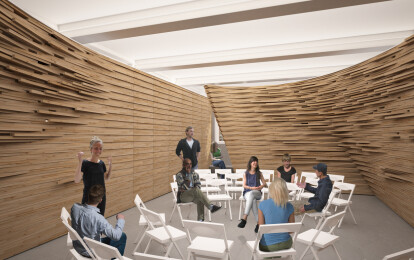The architectural practice of Min | Day draws on E.B. Min and Jeffrey Day’s backgrounds in art, landscape, and architecture to provide informed, flexible design for a wide range of clients, sites, and projects—from individuals to art institutions, urban to rural settings, and furniture to large buildings. We explore opportunities for innovation in program, materials, and fabrication, as well as in methods of practice, through a diverse set of project types and scales of intervention, coaxing nuance and specificity from the unique opportunities of the site and project at hand. Combining vernacular building methods and conventional forms of standardization with advanced digital fabrication, we develop efficient, alternative building systems incorporating sustainable materials and practices.
Projects exploit the interplay between actual and implied volumes and natural and applied color, shaping places that can be appreciated both for their architectural discipline and the sheer pleasure they afford. Surface materiality and color are important tools of space making that can reinforce or contradict the other components of spatial geometry, intensifying the experience or adding complexity. Our work is rigorously detailed while eschewing strict formal order in favor of responsive, flexible spaces that remain open to the improvisations of everyday life. Design rigor, we believe, can—and should—enable playfulness as well as sobriety.
Our physical offices are laboratories for material research and exploration, but much of our practice is virtual and transportable, employing on-line and cloud computing tools to enable fluid collaboration remotely. Additionally, we conduct design research and experimentation in collaboration with our allied practice, FACT (Fabrication and Construction Team), staffed by students of architecture. With FACT, we undertake art installations, exhibitions and commissions from creative non-profit organizations, often resulting in innovative social spaces (one current project is a community food & education center for an urban agriculture non-profit). Designing for socially engaged, non-profit art and cultural organizations, for which capital development is a slow and discontinuous process, we can’t depend on rigorous control over form, light, and detail. Instead, we seek ways of structuring experience that will serve to unify the work of others who will succeed us. Taking cues from a landscape design sensibility affords a productive approach to such projects with uncertain futures.






